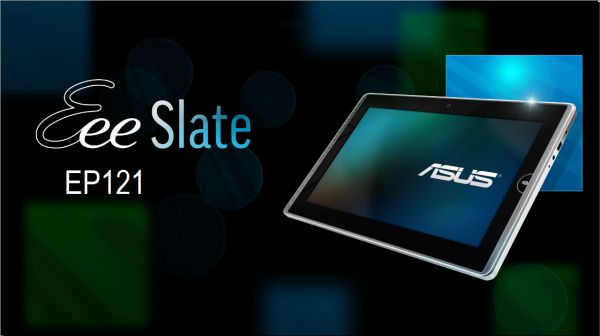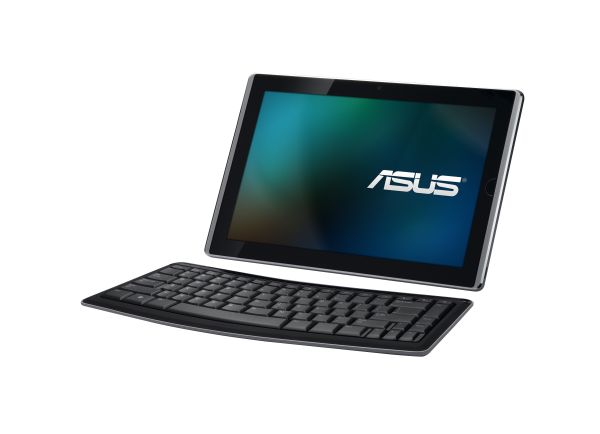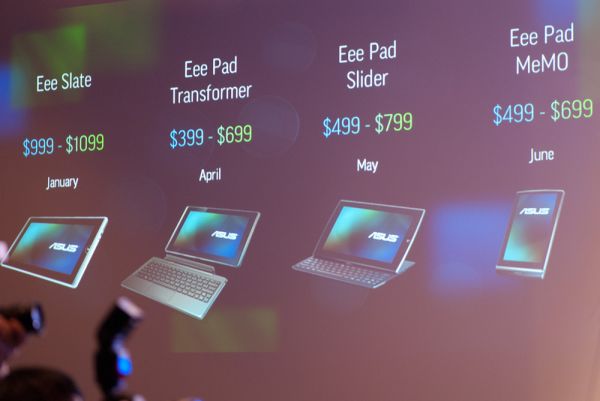ASUS Announces Eee Pad and Eee Slate Tablets
by Vivek Gowri on January 4, 2011 5:42 PM EST
And lastly, we have the Windows-based Eee Slate EP121 (I really don’t know where they come up with these names). There’s some history here, dating back to 2006 when ASUS first launched the R2h UMPC and R1F convertible tablet. They were ASUS’ first serious entry to the touchscreen PC market, and continued into the Eee PC T91 and T101 convertible netbooks. The Eee Pads and Eee Slate together will replace those.
The EP121 has Windows 7 Home Premium running on top of a Core i5-470UM, 2 or 4GB memory, and 32 or 64GB of flash storage. The 12.1” IPS panel has a 16:10 aspect ratio and WXGA resolution (1280x800), but most importantly features a Wacom active digitizer for pen-based handwriting recognition. The rest of the specs are pretty straightforward—a 2.0MP front facing camera, SDHC/SDXC card reader, one USB port, mini-HDMI, Bluetooth 3.0, and 2.4GHz 802.11n. A Bluetooth keyboard is included with the EP121; it looks to be a branded version of Microsoft’s Bluetooth Mobile Keyboard 6000.
In essence, the EP121 is a slate tablet PC with higher-end ultraportable internals. The combination of very respectable specs and the Wacom-enabled IPS display go a long way towards justifying the somewhat steep $999 cost, though given what HP is charging for its Atom-based 8.9” Slate ($799, to jog your memory), that figure looks almost reasonable. For $200 more, the ASUS has a lot more computing power and more features, though at 2.55lbs it’s a fair bit larger and heavier.
With that said, it’s still pretty thin and light, especially compared to some of the business-class convertible tablets on the market. I’m liking the overall package, since it balances power, portability, and price well along with the IPS display and Wacom digitizer. I think something that has gone mostly under the radar with the advent of tablets is the return of IPS displays in mobile computers—for a long time, IBM was the last one to offer IPS displays on their ThinkPad T series, but even they dumped the option in early 2007. Tablets are bringing IPS back, and that’s a very good thing.
The thing is, great specs or not, $999 is still a pretty hefty sum of money for a tablet, so I don’t forsee the EP121 making a huge sales dent. It’ll make a lot of sense for some users, like our smartphone editor Brian Klug, but it’s not really a tablet that can be recommended unless you want Windows and a Wacom digitizer. For a student looking for an ultraportable system, it looks like a very interesting option, and it’s definitely on the radar for inking fans, but at this point in time, I just don’t think that a Windows-based tablet solution is ideal for the majority of the tablet market. Either way, the Eee Slate should be available this quarter.
Wrap-Up
So that's the first CES salvo in what is sure to be a barrage of slate and tablet devices. ASUS is setting the standard with IPS displays across their lineup, which we'd love to see more of elsewhere. (Hint: we're tired of TN panel laptops!) The pricing looks reasonable, and the feature set is good as well. Perhaps the biggest drawback is that outside of the Slate, these are all targeting Q2/Q3 release dates, which means they're still a ways off from retail availability, but they might be worth the wait.













37 Comments
View All Comments
wifiwolf - Tuesday, January 4, 2011 - link
That's what i'm hoping. Sure notebook panels have been improving but not as much as I would expect - it's more marketing talk all around HD, LED, 3D. But nothing about image quality directly. All those are indirect ways to improve quality but I hope this is a trend beginning now not only for tablets but for every display. If not, at least for products which the price is already a premium and it doesn't make sense to be cheap (1000$+ notebooks for instance).mcnabney - Tuesday, January 4, 2011 - link
Slates practically require the IPS screen, especially when the iPad which defines the device has one.A desktop screen doesn't really need the IPS screen since the user generally sets it up to be best viewed from the seated position. Slates are constantly held at many angles and require the enhanced viewing angles to maintain the user experience.
softdrinkviking - Saturday, May 28, 2011 - link
100% agree.i won't buy a slate or another smartphone that has a crappy TN panel in it. i want ips or better from now on. those devices are like 75% screen.
hvakrg - Tuesday, January 4, 2011 - link
Does the Windows slate come with a HDMI dock, or is that extra?Chinoman - Tuesday, January 4, 2011 - link
At that price and size it's hard for me to not see the EP121 in comparison to the 11" MBA. Can anyone else see them competing?damianrobertjones - Wednesday, January 5, 2011 - link
No, as one's a computer and one's a tabletmichael2k - Wednesday, January 5, 2011 - link
What's the difference between a computer and a tablet?Given that the tablet runs Windows 7, has a 12.1" screen, and a core i5, I think it's actually more similar than dissimilar. One bluetooth keyboard and you have a valid MBA competitor.
LostPassword - Tuesday, January 4, 2011 - link
well at least we know those rumours about honey comb system requirements are wrong. but with these prices, i think i'm just going to keep my g tablet i got on sale.snoozemode - Tuesday, January 4, 2011 - link
The Transformer is awesome. This type of dock should be offered to all tablets by their respective manufactures.The Slider, nah, I think they prolly just released that product to see the demand. Don't think there will be a successor to that.
stlc8tr - Tuesday, January 4, 2011 - link
Do any of these tablets have GPS capability?